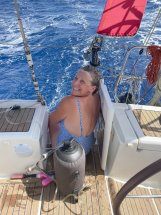Cassini Blog#61 - Running down the rhum line to the rum

|
We passed the halfway mark, 1080 miles,
on our voyage across the Atlantic yesterday, marked with a beer and snacks to
accompany lunch, and later in the evening, a three-course meal. Delicious. We’ve had more wind for the last three
days, resulting in our daily runs increasing from a little more than 120 miles a
day (at most) to between 140-150, a welcome change from the light wind start
from Mindelo. The higher winds and swells of the last three days have made it
more difficult to come up with the best adjustment to Mildred the Hydrovane – in
an ocean swell she needs more of the subtlety of Strictly’s Anton Du Beke than
one of the brash youngsters, to ensure Cassini’s 16 tons are manoeuvred on a
consistent and manageable course across the ocean. The surface sea weed has been a real
issue for us, almost since leaving Mindelo. It’s attaching itself to the Watt
& Sea hydrogenator and the Hydrovane rudder, and resulting in the
watchkeepers having to reach in and remove the stuff or trip the generator
upwards so it can release the debris and continue to function properly several
times in each three-hour watch. If we could find way to cook it, it would be ok,
but despite our creativity to date, I think this is beyond us. The precautions we took to reduce chafe
on the rigging and sails seem to be working well, with the extra Dyneema sleaves
taking the wear that would otherwise be on the polyester halyards, reefing lines
and headsail sheets. We’ve also adjusted the halyards to ensure that wear, where
it does take place, is distributed rather than concentrated in one place. The
care and attention that we took to repair and re-enforce the white sails this
winter has paid off, as they remain in excellent condition. The blown-out
cruising chute last week was probably a result of age and long use – there’s
always a time when they eventually let go since the material is so lightweight.
The failure was quite spectacular as a rip went from bottom to top, but recovery
was straightforward, and you never know, Sally might find a way to sew something
creative from the remnants. It’s sailing days are done though, and we’ll want to
find a replacement sometime. All the effort that Snakehips put into
provisioning is paying off. Once the fresh food had run down, the variety of
options from various tins have delivered meals like cassoulet, chicken curry and
cannelloni and artichoke heart salad. The enormous orange box is slowly being
depleted. After a dearth of caught fish on leg 1, Durks struck early in Leg 2
with a large wahoo, some big mahi mahi and a few smaller dorado – a relief for
him (and his fisherman reputation) and delicious eating for all of us. They all
made for excellent meals, either with salad, couscous or just as goujons for a
starter. The only real concerns remain water
usage, battery capacity/ charge and fridge temperatures (and the need to run
them longer to sustain low temperatures). After beginning the Rally at a mere 35-40
lt of water consumed per day, it has increased to over 60 now. We have an extra
crew member now, with longer hair than the rest of us – enough said I think
Sarah! The 60lt water maker has done good service though, but consumes amps from
the battery at an alarming rate if left on for more than an hour.
The largest draw on the battery is our
two fridges, consuming something like 25 percent of the installed battery
capacity overnight when they are both running. As the water and air temperature
have increased, the run time on fridges has also increased. We’ve re-jigged the
food that needs to be kept cold into a single top loading fridge now and
isolated the front-loading one which now serves as ready use storage. The drop
in power usage is noticeable and sufficient to ensure that the methods of
generation just about keep ahead of usage. As Mr Micawber might have said in my
position, making more amps than we’re using, bliss! Looking forward now to the last 850
miles, with hopefully more consistent wind to take us into
Grenada. Simon |
